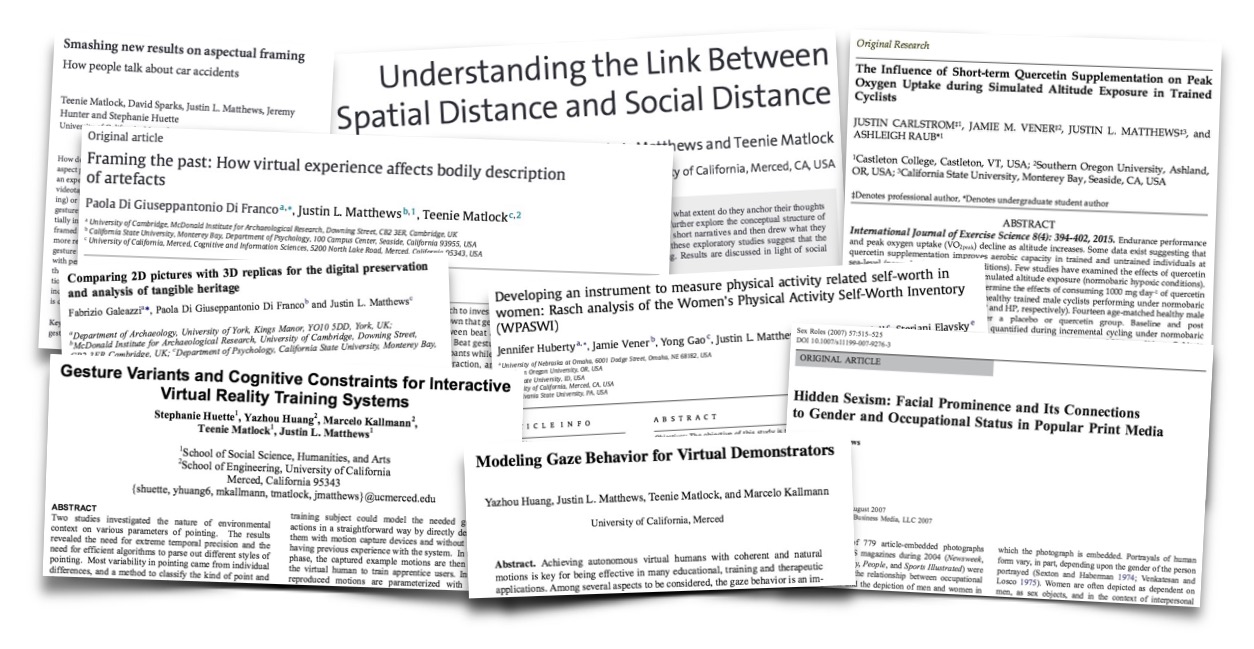Di Giuseppantonio Di Franco, P., Matthews, J.L., & Matlock, T. (2016). Framing the past: How virtual experience affects our bodily description of artefacts. Journal of Cultural Heritage. [link]
Carlstrom, J., Vener, J.M., Matthews, J.L., & Raub, A. (2015). The influence of short-term quercetin supplementation on peak oxygen uptake during simulated altitude exposure in trained cyclists. International Journal of Exercise Science, 8, 394-402. [link]
Di Giuseppantonio Di Franco, P., Galeazzi, F., & Matthews, J.L. (2015). Comparing 2D pictures with 3D replicas for the digital preservation and analysis of tangible heritage. Museum Management and Curatorship. [link]
Huberty, J.L., Vener, J., Gao, Y., Matthews, J.L., Ransdell, L.B., & Elavsky, S. (2013). Developing an instrument to measure physical activity related self-worth in women: Rasch analysis of the Women’s Physical Activity Self-Worth Inventory (WPASWI). Psychology of Sport & Exercise, 14, 111-121. doi:http://dx.doi.org/10.1016/j.psychsport.2012.07.009 [link]
Matlock, T., Sparks, D., Matthews, J.L., Hunter, J., & Huette, S. (2012). Smashing new results on aspectual framing: How people talk about car accidents. Theory and data in cognitive linguistics: Special issue of Studies in Language, 36, 699-720. doi:http://dx.doi.org/10.1075/sl.36.3.09mat [link]
Huang, Y., Matthews, J.L., Matlock, T., & Kallmann, M. (2011). Modeling gaze behavior for virtual demonstrators. In H. Högni Vilhjálmsson et al. (Eds.), Proceedings paper of the 11th International Conference on Intelligent Virtual Agents, Reykjavík, Iceland, LNAI 6895 (pp. 155-161). Berlin/Heidelberg: Springer-Verlag. doi:10.1007/978-3-642-23974-8_17 [link]
Huette, S., Huang, Y., Kallmann, M., Matlock, T., & Matthews, J.L. (2011). Gesture variants and cognitive constraints for interactive virtual reality training systems. Proceedings paper of the 15th International Conference on Intelligent User Interfaces, Palo Alto, CA. doi:10.1145/1943403.1943463 [link]
Matthews, J.L. & Matlock, T. (2011). Understanding the link between spatial distance and social distance. Social Psychology, 42, 185-192. doi:10.1027/1864-9335/a000062 [link]
Matthews, J.L. & Matlock, T. (2010). The spatial and temporal underpinnings of social distance. In C. Hölscher et al. (Eds.), Spatial Cognition VII, LNAI 6222 (pp. 19-31). Berlin/Heidelberg: Springer-Verlag. doi:10.1007/978-3-642-14749-4 [link]
Matthews, J.L. (2007). Hidden sexism: Facial prominence and its connections to gender and occupational status in popular print media. Sex Roles: A Journal of Research, 57, 515-525. doi:10.1007/s11199-007-9276-3 [link]
Sharps, M.J., Matthews, J., & Asten, J. (2006). Cognition and belief in paranormal phenomena: Gestalt/feature-intensive processing theory and tendencies toward ADHD, depression, and dissociation. The Journal of Psychology: Interdisciplinary and Applied, 140, 579-590. doi:10.3200/JRLP.140.6.579-590 [link]
Sharps, M.J., Villegas, A.B. & Matthews, J. (2005). Cognition at risk: Gestalt/feature-intensive processing and cigarette smoking in college students. Journal of Current Psychology, 24, 102-112. doi:10.1007/s12144-005-1009-6 [link]
**Documents are provided for personal use only. Downloading a document is considered a request by you for a single copy. Do not circulate or disseminate.

